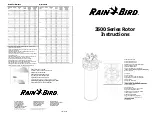
Section 4 Defining Optical Filters
4.1
Optical Filter Files
The WaveShaper Series A supports two different input file formats;
*.ucf and *.wsp.
File Type
File Suffix
Description
Supported By
User Configured Filter
*.ucf
Controls basic WaveShaper Functionality
All models except 100A
Preset
*.wsp
Allows the user to load Preset WaveShaper Configurations
All models except 100A
Note:
WaveShaper 500A does not support phase control, but can read *.ucf and *.wsp files and apply the amplitude control function therein.
4.2
User Configured Filters (*.ucf)
The ability to load and then easily control user configured filters is key to the operation of the WaveShaper. To this end, the
WaveShaper App supports the same .ucf file import format used in previous versions of the WaveShaper software.
To ensure data integrity, the software will parse and truncate/interpolate the .ucf file to ensure the requested filter shape is
calculated to conform to the limits set by the WaveShaper capabilities. The following rules for preparing and interpreting the .ucf
files therefore apply.
The number of frequency data points must be at least one. The interpolation in the WaveManager software chooses the
attenuation and phase values corresponding to the frequency value that is nearest to the respective frequency in the WaveShaper.
Hence, if there is only one point defined, all frequencies will be set to the same attenuation and phase values defined by that
point. Any WaveShaper frequency outside of the defined frequency range of the input file will be set to the respective edge points
of the input file definition, as that will be the nearest neighbour to these frequencies.
For optimal consistency and portability of .ucf files between different WaveShapers, it is recommended to specify the profiles
down to a resolution of 1 GHz.
File Structure
The format of a "
.ucf" file is a tab delimited text file with three columns: Frequency Offset (THz), Attenuation (dB) and Phase (Rad).
The file can be generated using a spreadsheet program, such as Microsoft Excel (saving the document as a tab delimited text file).
The file extension must set to be “
.ucf”.
Frequency
The filter frequency is defined in THz as the detuning (positive and negative) from an arbitrary center frequency. The frequencies
do not have to be balanced around the center frequency, but the frequency data set must contain one, and only one, value of
zero, which the WaveShaper interprets as the center frequency. The values in the frequency column must also be monotonically
increasing. Each frequency data point must have a corresponding value of Attenuation and Phase. If no specific attenuation or
phase value is required, values of 0 must be specified at these points.
Attenuation
The calibrated attenuation values available in the WaveShaper hardware are 0 to 30 dB . However, the WaveShaper hardware will
control attenuation down to (maximally) 40 dB and also provides a ‘Block’ state with attenuation of typically >50 dB. To guarantee
the portability of filter shapes between WaveShaper units, the
*.ucf attenuation range should be limited to 0-30 dB. The
interpretation of the
*.ucf files provides access to the full range of attenuation controls as follows:
WaveShaper A Series User Manual
30
















































